engine Hyundai Ioniq Electric 2017 Quick Reference Guide
[x] Cancel search | Manufacturer: HYUNDAI, Model Year: 2017, Model line: Ioniq Electric, Model: Hyundai Ioniq Electric 2017Pages: 26, PDF Size: 9.24 MB
Page 1 of 26
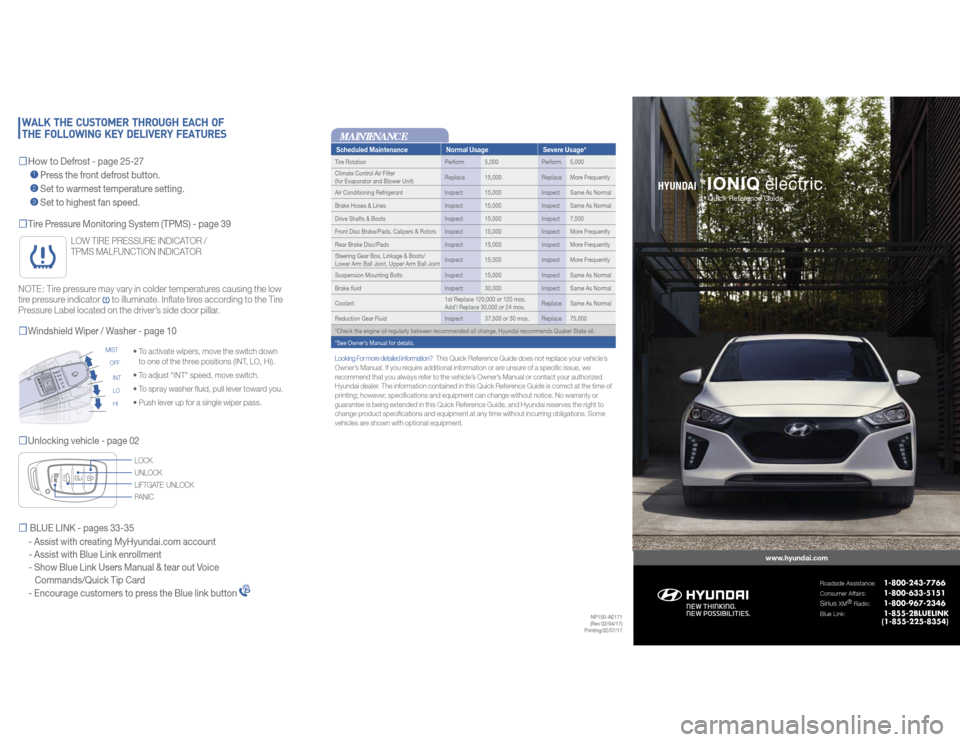
IONIQ
electricwww.hyundai.com
Roadside Assistance:
1-800-243-7766
Consumer Affairs:
1-800-633-5151
Sirius
XM®
Radio:
1-800-967-2346
Blue Link:
1-855-2BLUELINK
(1-855-225-8354)
HYUNDAI
Quick Reference Guide
☐Tire Pressure Monitoring System (TPMS) - page 39☐Unlocking vehicle - page 02
• To activate wipers, move the switch down
to one of the three positions (INT, LO, HI).
• To adjust "INT" speed, move switch.
• To spray washer fluid, pull lever toward you.
• Push lever up for a single wiper pass.
☐Windshield Wiper / Washer - page 10
INT
LO
HI MIST
OFF
UNLOCK
LIFTGATE UNLOCK LOCK
PANIC
NOTE: Tire pressure may vary in colder temperatures causing the low
tire pressure indicator
to illuminate. Inflate tires according to the Tire
Pressure Label located on the driver’s side door pillar.
LOW TIRE PRESSURE INDICATOR /
TPMS MALFUNCTION INDICATOR
NP150-AE171
(Rev 02/04/17)
Printing 02/07/17
Looking For more detailed information?
This Quick Reference Guide does not replace your vehicle’s
Owner’s Manual. If you require additional information or are unsure of a specific issue, we
recommend that you always refer to the vehicle’s Owner’s Manual or contact your authorized
Hyundai dealer. The information contained in this Quick Reference Guide is correct at the time of
printing; however, specifications and equipment can change without notice. No warranty or
guarantee is being extended in this Quick Reference Guide, and Hyundai reserves the right to
change product specifications and equipment at any time without incurring obligations. Some
vehicles are shown with optional equipment.
MAINTENANCEScheduled Maintenance Normal Usage Severe Usage*Tire Rotation Perform 5,000 Perform 5,000
Climate Control Air Filter
(for Evaporator and Blower Unit)Replace 15,000 Replace More Frequently
Air Conditioning Refrigerant Inspect 15,000 Inspect Same As Normal
Brake Hoses & Lines Inspect 15,000 Inspect Same As Normal
Drive Shafts & Boots Inspect 15,000 Inspect 7,500
Front Disc Brake/Pads, Calipers & Rotors Inspect 15,000 Inspect More Frequently
Rear Brake Disc/Pads Inspect 15,000 Inspect More Frequently
Steering Gear Box, Linkage & Boots/
Lower Arm Ball Joint, Upper Arm Ball JointInspect 15,000 Inspect More Frequently
Suspension Mounting Bolts Inspect 15,000 Inspect Same As Normal
Brake fluid Inspect 30,000 Inspect Same As Normal
Coolant1st Replace 120,000 or 120 mos.
Add’l Replace 30,000 or 24 mos.Replace Same As Normal
Reduction Gear Fluid Inspect 37,500 or 30 mos. Replace 75,000
*Check the engine oil regularly between recommended oil change. Hyundai recommends Quaker State oil.
*See Owner’s Manual for details.
☐How to
Defrost - page 25-27
1 Press the front defrost button.
2 Set to warmest temperature setting.
3 Set to highest fan speed.
WALK THE CUSTOMER THROUGH EACH OF
THE FOLLOWING KEY DELIVERY FEATURES☐ BLUE LINK - pages 33-35
- Assist with creating MyHyundai.com account
- Assist with Blue Link enrollment
- Show Blue Link Users Manual & tear out Voice
Commands/Quick Tip Card
- Encourage customers to press the Blue link button
Page 2 of 26
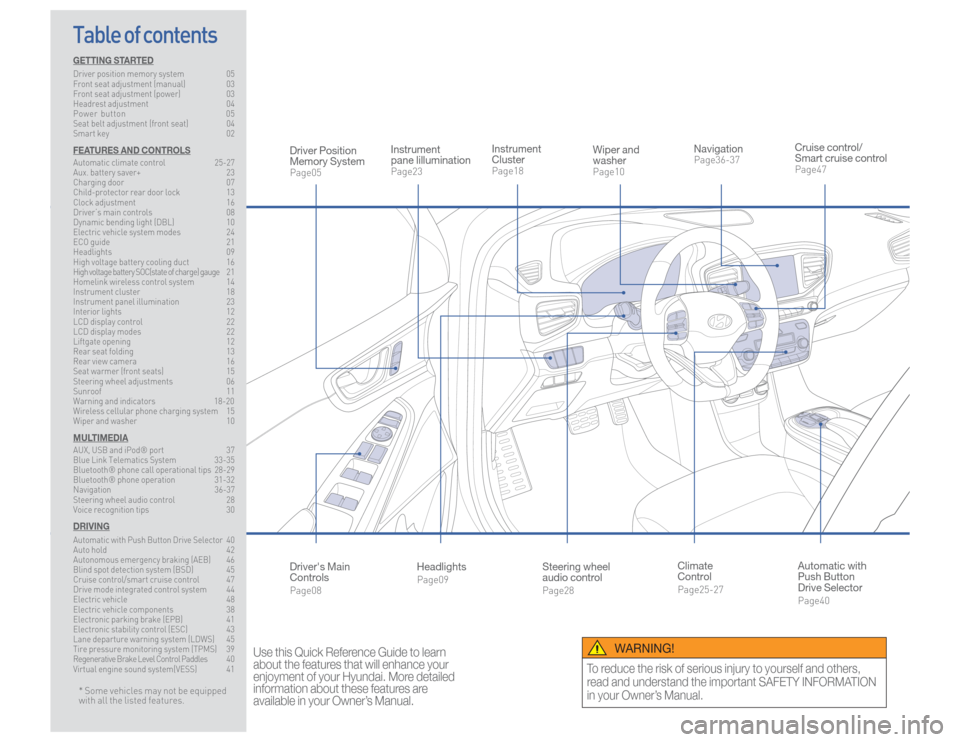
Steering wheel
audio controlPage28
Instrument
ClusterPage18
NavigationPage36-37
Instrument
pane lillumination Page23
Climate
ControlPage25-27
HeadlightsPage09
Table of contents
Cruise control/
Smart cruise controlPage47
Wiper and
washerPage10
Automatic with
Push Button
Drive SelectorPage40
Driver Position
Memory SystemPage05
WARNING!
To reduce the risk of serious injury to yourself and others,
read and understand the important SAFETY INFORMATION
in your Owner’s Manual.
* Some vehicles may not be equipped
with all the listed features.
Use this Quick Reference Guide to learn
about the features that will enhance your
enjoyment of your Hyundai. More detailed
information about these features are
available in your Owner’s Manual.
Driver's Main
ControlsPage08
GETTING STARTEDDriver position memory system 05
Front seat adjustment (manual) 03
Front seat adjustment (power) 03
Headrest adjustment 04
Power button 05
Seat belt adjustment (front seat) 04
Smart key 02FEATURES AND CONTROLSAutomatic climate control 25-27
Aux. battery saver+ 23
Charging door 07
Child-protector rear door lock 13
Clock adjustment 16
Driver’s main controls 08
Dynamic bending light (DBL) 10
Electric vehicle system modes 24
ECO guide 21
Headlights 09
High voltage battery cooling duct 16
High voltage battery SOC(state of charge) gauge 2 1
Homelink wireless control system 14
Instrument cluster 18
Instrument panel illumination 23
Interior lights 12
LCD display control 22
LCD display modes 22
Liftgate opening 12
Rear seat folding 13
Rear view camera 16
Seat warmer (front seats) 15
Steering wheel adjustments 06
Sunroof 11
Warning and indicators 18-20
Wireless cellular phone charging system 15
Wiper and washer 10MULTIMEDIAAUX, USB and iPod® port 37
Blue Link Telematics System 33-35
Bluetooth® phone call operational tips 28-29
Bluetooth® phone operation 31-32
Navigation 36-37
Steering wheel audio control 28
Voice recognition tips 30DRIVINGAutomatic with Push Button Drive Selector
40
Auto hold 42
Autonomous emergency braking (AEB) 46
Blind spot detection system (BSD) 45
Cruise control/smart cruise control 47
Drive mode integrated control system 44
Electric vehicle 48
Electric vehicle components 38
Electronic parking brake (EPB) 41
Electronic stability control (ESC) 43
Lane departure warning system (LDWS) 45
Tire pressure monitoring system (TPMS) 39
Regenerative Brake Level Control Paddles 40
Virtual engine sound system(VESS) 41
Page 9 of 26
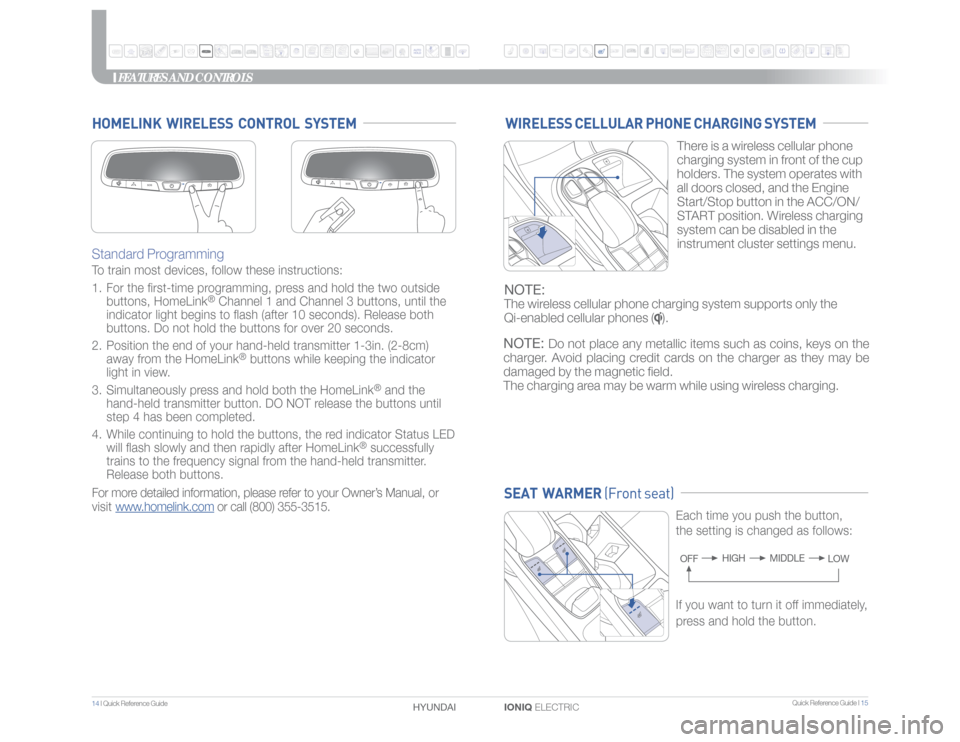
Quick Reference Guide I 15
14 I Quick Reference Guide
IONIQ ELECTRIC HYUNDAI
Standard Programming To train most devices, follow these instructions:
1. For the first-time programming, press and hold the two outside
buttons, HomeLink
® Channel 1 and Channel 3 buttons, until the
indicator light begins to flash (after 10 seconds). Release both
buttons. Do not hold the buttons for over 20 seconds.
2. Position the end of your hand-held transmitter 1-3in. (2-8cm)
away from the HomeLink
® buttons while keeping the indicator
light in view.
3. Simultaneously press and hold both the HomeLink
® and the
hand-held transmitter button. DO NOT release the buttons until
step 4 has been completed.
4. While continuing to hold the buttons, the red indicator Status LED
will flash slowly and then rapidly after HomeLink
® successfully
trains to the frequency signal from the hand-held transmitter.
Release both buttons.
For more detailed information, please refer to your Owner’s Manual, or
visit www.homelink.com or call (800) 355-3515.
HOMELINK WIRELESS CONTROL SYSTEM
SEAT WARMER (Front seat)
Each time you push the button,
the setting is changed as follows:OFFMIDDLE HIGH
LOW
FEATURES AND CONTROLS
WIRELESS CELLULAR PHONE CHARGING SYSTEM
If you want to turn it off immediately,
press and hold the button.There is a wireless cellular phone
charging system in front of the cup
holders. The system operates with
all doors closed, and the Engine
Start/Stop button in the ACC/ON/
START position. Wireless charging
system can be disabled in the
instrument cluster settings menu.
NOTE:The wireless cellular phone charging system supports only the
Qi-enabled cellular phones (
).
NOTE:
Do not place any metallic items such as coins, keys on the
charger. Avoid placing credit cards on the charger as they may be
damaged by the magnetic field.
The charging area may be warm while using wireless charging.
Page 19 of 26
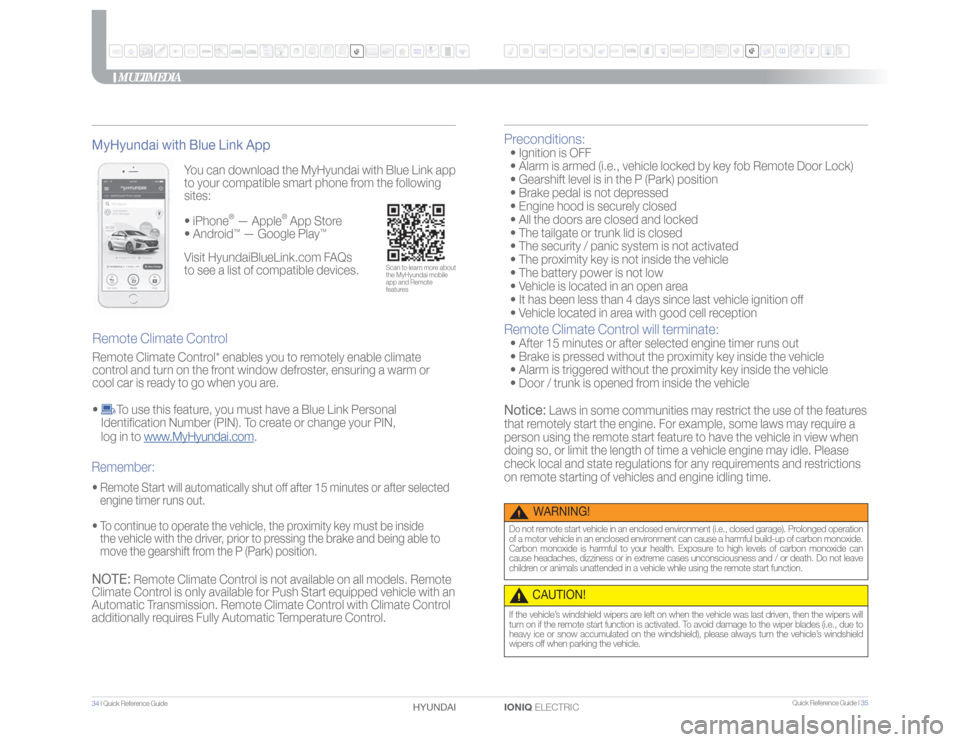
Quick Reference Guide I 35
34 I Quick Reference Guide
IONIQ ELECTRIC HYUNDAI
MULTIMEDIA
You can download the MyHyundai with Blue Link app
to your compatible smart phone from the following
sites: • iPhone
® — Apple
® App Store
• Android
™ — Google Play
™
Remote Climate Control MyHyundai with Blue Link App• Remote Start will automatically shut off after 15 minutes or after selected
engine timer runs out.
• To continue to operate the vehicle, the proximity key must be inside
the vehicle with the driver, prior to pressing the brake and being able to
move the gearshift from the P (Park) position.Remember:
Scan to learn more about
the MyHyundai mobile
app and Remote
features
Visit HyundaiBlueLink.com FAQs
to see a list of compatible devices.
NOTE:
Remote Climate Control is not available on all models. Remote
Climate Control is only available for Push Start equipped vehicle with an
Automatic Transmission. Remote Climate Control with Climate Control
additionally requires Fully Automatic Temperature Control.
Preconditions: • Ignition is OFF
• Alarm is armed (i.e., vehicle locked by key fob Remote Door Lock)
• Gearshift level is in the P (Park) position
• Brake pedal is not depressed
• Engine hood is securely closed
• All the doors are closed and locked
• The tailgate or trunk lid is closed
• The security / panic system is not activated
• The proximity key is not inside the vehicle
• The battery power is not low
• Vehicle is located in an open area
• It has been less than 4 days since last vehicle ignition off
• Vehicle located in area with good cell receptionRemote Climate Control will terminate: • After 15 minutes or after selected engine timer runs out
• Brake is pressed without the proximity key inside the vehicle
• Alarm is triggered without the proximity key inside the vehicle
• Door / trunk is opened from inside the vehicleNotice:
Laws in some communities may restrict the use of the features
that remotely start the engine. For example, some laws may require a
person using the remote start feature to have the vehicle in view when
doing so, or limit the length of time a vehicle engine may idle. Please
check local and state regulations for any requirements and restrictions
on remote starting of vehicles and engine idling time.
WARNING!
Do not remote start vehicle in an enclosed environment (i.e., closed garage). Prolonged operation
of a motor vehicle in an enclosed environment can cause a harmful build-up of carbon monoxide.
Carbon monoxide is harmful to your health. Exposure to high levels of carbon monoxide can
cause headaches, dizziness or in extreme cases unconsciousness and / or death. Do not leave
children or animals unattended in a vehicle while using the remote start function.
CAUTION!If the vehicle’s windshield wipers are left on when the vehicle was last driven, then the wipers will
turn on if the remote start function is activated. To avoid damage to the wiper blades (i.e., due to
heavy ice or snow accumulated on the windshield), please always turn the vehicle’s windshield
wipers off when parking the vehicle.
Remote Climate Control* enables you to remotely enable climate
control and turn on the front window defroster, ensuring a warm or
cool car is ready to go when you are.
•
To use this feature, you must have a Blue Link Personal
Identification Number (PIN). To create or change your PIN,
log in to www.MyHyundai.com.
Page 21 of 26
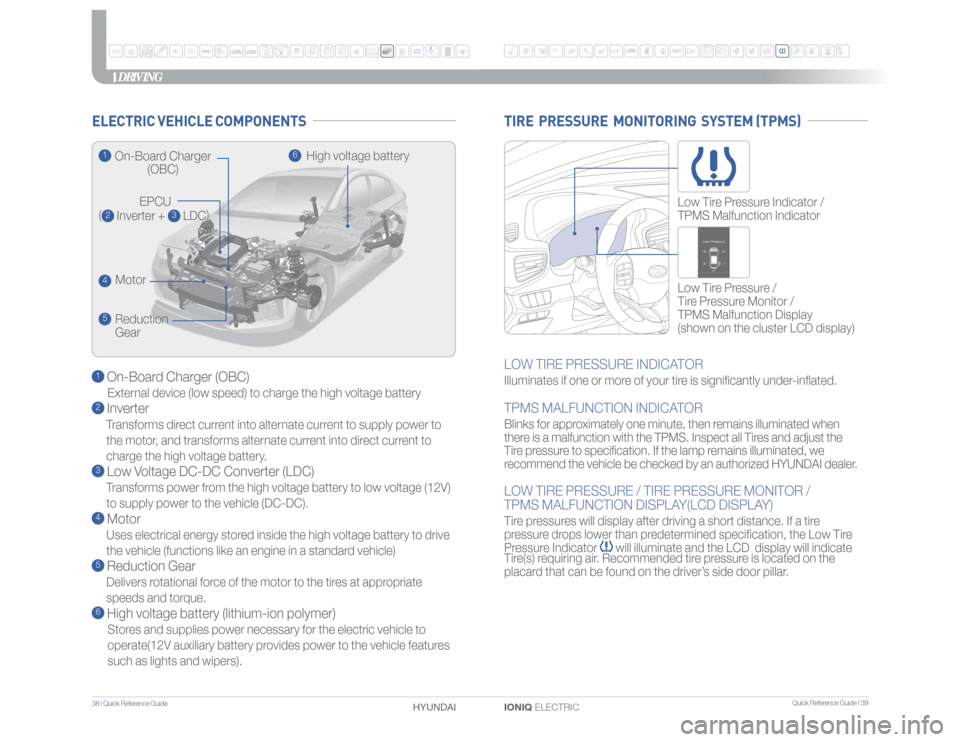
Quick Reference Guide I 39
38 I Quick Reference Guide
IONIQ ELECTRIC HYUNDAI
1 On-Board Charger (OBC)External device (low speed) to charge the high voltage battery2 InverterTransforms direct current into alternate current to supply power to
the motor, and transforms alternate current into direct current to
charge the high voltage battery.3 Low Voltage DC-DC Converter (LDC)Transforms power from the high voltage battery to low voltage (12V)
to supply power to the vehicle (DC-DC).4 MotorUses electrical energy stored inside the high voltage battery to drive
the vehicle (functions like an engine in a standard vehicle)5 Reduction GearDelivers rotational force of the motor to the tires at appropriate
speeds and torque.6 High voltage battery (lithium-ion polymer)Stores and supplies power necessary for the electric vehicle to
operate(12V auxiliary battery provides power to the vehicle features
such as lights and wipers).
ELECTRIC VEHICLE COMPONENTS
DRIVING
LOW TIRE PRESSURE INDICATORIlluminates if one or more of your tire is significantly under-inflated.TPMS MALFUNCTION INDICATORBlinks for approximately one minute, then remains illuminated when
there is a malfunction with the TPMS. Inspect all Tires and adjust the
Tire pressure to specification. If the lamp remains illuminated, we
recommend the vehicle be checked by an authorized HYUNDAI dealer.LOW TIRE PRESSURE / TIRE PRESSURE MONITOR /
TPMS MALFUNCTION DISPLAY(LCD DISPLAY)Tire pressures will display after driving a short distance. If a tire
pressure drops lower than predetermined specification, the Low Tire
Pressure Indicator
will illuminate and the LCD display will indicate
Tire(s) requiring air. Recommended tire pressure is located on the
placard that can be found on the driver’s side door pillar.Low Tire Pressure /
Tire Pressure Monitor /
TPMS Malfunction Display
(shown on the cluster LCD display) Low Tire Pressure Indicator /
TPMS Malfunction Indicator
TIRE PRESSURE MONITORING SYSTEM (TPMS)
1
On-Board Charger
(OBC)
EPCU
(2 Inverter +
3 LDC)
4
Motor
5
Reduction
Gear
6
High voltage battery
Page 22 of 26
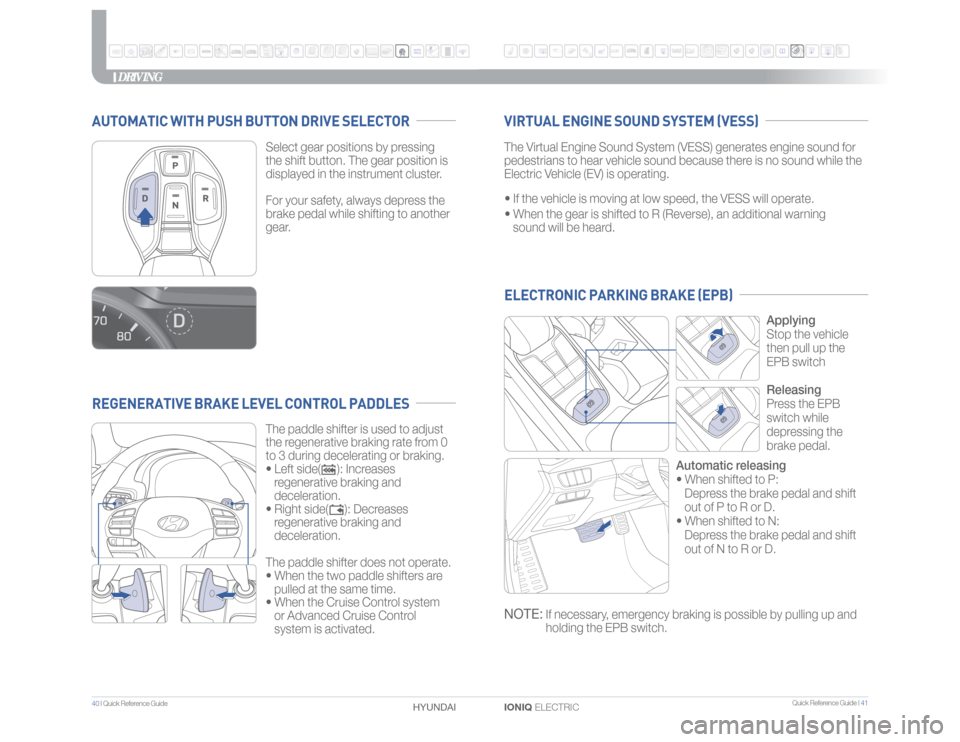
Quick Reference Guide I 41
40 I Quick Reference Guide
IONIQ ELECTRIC HYUNDAI
DRIVING
AUTOMATIC WITH PUSH BUTTON DRIVE SELECTORREGENERATIVE BRAKE LEVEL CONTROL PADDLES
ELECTRONIC PARKING BRAKE (EPB)VIRTUAL ENGINE SOUND SYSTEM (VESS)
Select gear positions by pressing
the shift button. The gear position is
displayed in the instrument cluster.
For your safety, always depress the
brake pedal while shifting to another
gear.
The paddle shifter is used to adjust
the regenerative braking rate from 0
to 3 during decelerating or braking.
• Left side( ): Increases
regenerative braking and
deceleration.
• Right side( ): Decreases
regenerative braking and
deceleration.
The paddle shifter does not operate.
• When the two paddle shifters are
pulled at the same time.
• When the Cruise Control system
or Advanced Cruise Control
system is activated.The Virtual Engine Sound System (VESS) generates engine sound for
pedestrians to hear vehicle sound because there is no sound while the
Electric Vehicle (EV) is operating.
• If the vehicle is moving at low speed, the VESS will operate.
• When the gear is shifted to R (Reverse), an additional warning
sound will be heard.
Applying
Stop the vehicle
then pull up the
EPB switch
Releasing
Press the EPB
switch while
depressing the
brake pedal.
Automatic releasing
• When shifted to P:
Depress the brake pedal and shift
out of P to R or D.
• When shifted to N:
Depress the brake pedal and shift
out of N to R or D.
NOTE:
If necessary, emergency braking is possible by pulling up and
holding the EPB switch.
Page 23 of 26
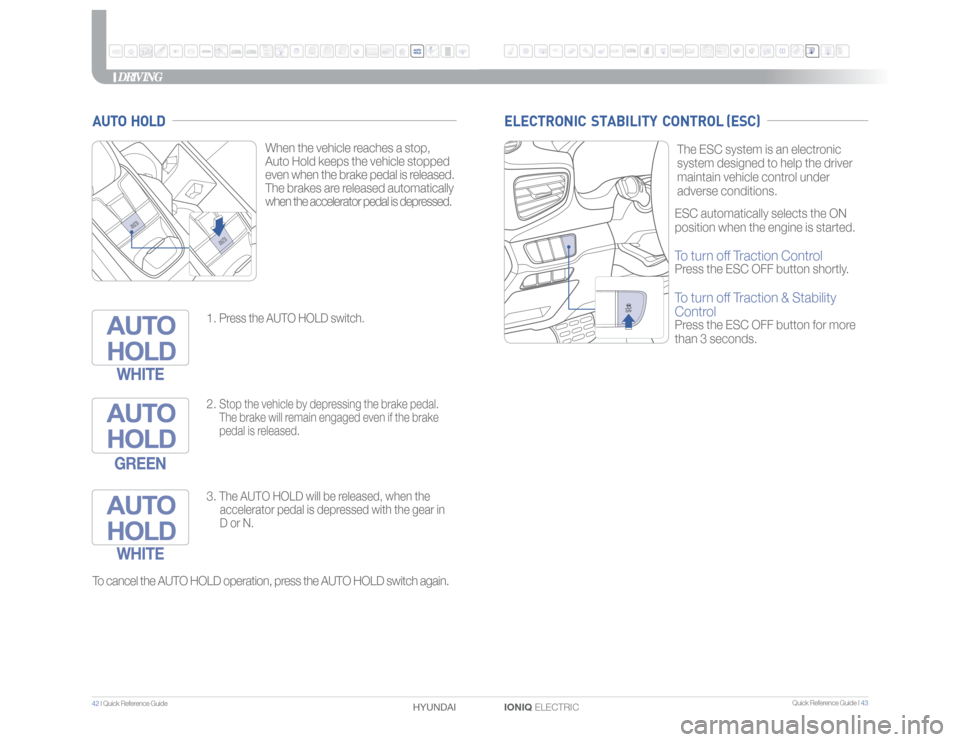
Quick Reference Guide I 43
42 I Quick Reference Guide
IONIQ ELECTRIC HYUNDAI
DRIVING
To cancel the AUTO HOLD operation, press the AUTO HOLD switch again.When the vehicle reaches a stop,
Auto Hold keeps the vehicle stopped
even when the brake pedal is released.
The brakes are released automatically
when the accelerator pedal is depressed.
1.
Press the AUTO HOLD switch.
WHITE
2.
Stop the vehicle by depressing the brake pedal.
The brake will remain engaged even if the brake
pedal is released.
GREEN
3.
The AUTO HOLD will be released, when the
accelerator pedal is depressed with the gear in
D or N.
WHITE
ESC automatically selects the ON
position when the engine is started.To turn off Traction ControlPress the ESC OFF button shortly.To turn off Traction & Stability
ControlPress the ESC OFF button for more
than 3 seconds.The ESC system is an electronic
system designed to help the driver
maintain vehicle control under
adverse conditions.
ELECTRONIC STABILITY CONTROL (ESC)
AUTO HOLD